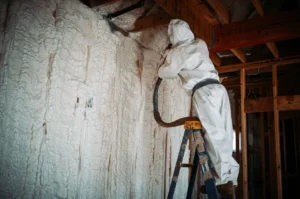When it comes to creating a cozy and energy-managed home, one often overlooked aspect is attic insulation. A well-insulated attic can significantly impact your home’s energy management, keeping it cool in the summer and warm in the winter. In this blog post, we’ll delve into attic insulation services, explore the options available, and help you make an informed decision for your home.
Why is Attic Insulation Important?
Before we jump into the specifics of these services, let’s understand why insulating your attic is crucial. Attic insulation creates a barrier, preventing heat transfer between your home and the outside environment. This helps regulate the indoor temperature, lowering the strain on your heating & cooling systems and lowering your energy bills.
Types of Attic Insulation Services
Fiberglass Insulation
One of the most popular preferences for attic insulation is fiberglass, which is cost-effective and easy to install. Its excellent thermal performance makes it an efficient option for maintaining a consistent indoor temperature. Fiberglass insulation is accessible in batts or rolls, making it suitable for different attic configurations.
Cellulose Insulation
Made from recycled paper, cellulose insulation is an eco-friendly option for reducing their carbon footprint. It is treated for fire resistance and provides effective insulation against heat and cold. Cellulose insulation is added to the attic space, ensuring seamless and comprehensive coverage.
Spray Foam Insulation
Known for its superior insulation properties, spray foam creates an airtight seal, minimizing heat loss or gain. It can expand to fill gaps and crevices, providing a complete barrier against drafts.
While slightly more expensive, the long-term energy savings often justify the initial investment.
Radiant Barrier Insulation
Reflective foil materials characterize radiant barrier insulation installed directly under the roof deck. It reflects radiant heat, preventing it from entering the attic and, subsequently, the living space below. This type of insulation is particularly useful in hot climates.
Choosing the Best Attic Insulation
Now that we’ve explored the various types of attic insulation, how do you determine which is best for your home? Consider the following factors:
Climatic Conditions: The local climate of any area plays a prime role in determining the most suitable insulation type. For colder climates, a higher R-value insulation is recommended.
Budget: Different insulation materials come with varying costs. Evaluate your budget & choose an option that balances upfront expenses with long-term energy savings.
Installation Ease: Some insulation materials are more effortlessly installed than others. If you’re considering a DIY approach, choose an option that aligns with your skill level.
Energy Efficiency Goals: If reducing the carbon footprint is your priority, opt for an eco-friendly insulation material such as cellulose or consider the energy efficiency of the chosen material.
What Method Is Most Effective for Insulating The Ceiling of An Attic?
Insulating the ceiling of an attic is a common & effective way to improve energy efficiency in a home. The choice of insulation method depends on factors such as your budget, the climate in your region, and the specific characteristics of your attic. Here are some commonly used methods for insulating attic ceilings:
Batt or Roll Insulation
Material: Fiberglass, mineral wool, or cotton.
Installation: Rolls or batts are laid between the ceiling joists. They are easy to install and can be a good option for accessible attics.
Blown-In Insulation
Material: Fiberglass, cellulose, or mineral wool.
Installation: Insulation is blown into the attic space using special equipment. This method is effective for irregularly shaped attics and hard-to-reach areas.
Spray Foam Insulation
Material: Polyurethane foam.
Installation: Applied as a liquid that expands and hardens. It provides an excellent air barrier and is added to the underside of the roof deck or between the joists.
Radiant Barrier
Material: Reflective foil.
Installation: Installed on the bottom of the roof deck to reflect radiant heat. It’s more effective in hot climates where radiant heat is a significant issue.
Rigid Foam Board Insulation
Material: Extruded or expanded polystyrene.
Installation: Boards are placed between the ceiling joists. This method provides good thermal resistance and can be effective in limited space.
Hybrid Insulation Systems
Combining different insulation materials or methods to maximize benefits. For example, using rigid foam board insulation in combination with blown-in insulation.
Also Read: What is the Best Way to Insulate Interior Walls for Sound?
Conclusion
Investing in the proper attic insulation service is crucial to creating a comfortable and energy-efficient home. By considering factors like climate, budget, installation, and energy efficiency goals, you can make an informed decision that suits your unique needs. Whether fiberglass, cellulose, spray foam or radiant barrier insulation, the key is creating a well-insulated attic that contributes to a more sustainable and cost-effective living space.
Ready to Elevate Your Home Comfort? Discover the Ultimate Attic Insulation Solution! Contact Air Seal Insulation in NYC. Call now and create a home that’s energy-efficient, cozy, and perfect for every season!




